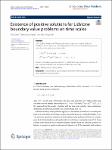Search
Author
- Carlos, Alegría (2)
- Carlos, Seara (2)
- David, Orden (2)
- Klaus, Bretterbauer (2)
- next >
Subject
Date issued
Has File(s)
- true (287)
Search Results
The viral load is known to be a chief predictor of the risk of transmission of infectious diseases. In this work, we investigate the role of the individuals’ viral load in the disease transmission by proposing a new susceptible-infectious-recovered epidemic model for the densities and mean viral loads of each compartment. To this aim, we formally derive the compartmental model from an appropriate microscopic one. Firstly, we consider a multi-agent system in which individuals are identified by the epidemiological compartment to which they belong and by their viral load. |
In recent years, scale-discretized directional wavelets and second-generation curvelets have been introduced on the unit sphere, yielding directional and localized polynomial frames for band-limited signals. In this paper, we show that these functions are able to detect the positions and orientations of all higher order jump discontinuities which lie along circles on the 2-sphere. Specifically, we prove upper and lower estimates for the magnitude of the corresponding inner products when the analysis function is concentrated in the neighborhood of such a singularity. |
This research is presenting and reflecting the philosophical analysis by Max Bense of the intellectual history of mathematics as a science of mind. Examples of important historical phases show corresponding relationships between mathematics and arts, including architecture and all areas of human creation abilities. |
We consider the transcendental entire function f(z)=z+e−z, which has a doubly parabolic Baker domain U of degree two, i.e. an invariant stable component for which all iterates converge locally uniformly to infinity, and for which the hyperbolic distance between successive iterates converges to zero. It is known from general results that the dynamics on the boundary is ergodic and recurrent and that the set of points in ∂U whose orbit escapes to infinity has zero harmonic measure. |
Lidstone boundary value problems appear as a mathematical model of real world problems such as the study of bending of simply supported beams or suspended bridges [4–6]. The existence of positive solutions of the boundary value problems (BVPs) has created a great deal of interest due to wide applicability in both theory and applications [7, 8]. Some authors in the literature have obtained existence results about the solutions, positive solutions, or symmetric positive solutions of Lidstone type BVPs associated with ordinary differential equations, differential equations, and dynamic equations on time scales by using various methods (see [7–24] and the references therein). |
We study (nonconvex) quadratic optimization problems with complementarity constraints, establishing an exact completely positive reformulation under—apparently new—mild conditions involving only the constraints, not the objective. Moreover, we also give the conditions for strong conic duality between the obtained completely positive problem and its dual. Our approach is based on purely continuous models which avoid any branching or use of large constants in implementation. |
We derive an adaptation of Li and Yau estimates for positive solutions of semilinear heat equations on Riemannian manifolds with nonnegative Ricci tensor. We then apply these estimates to obtain a Harnack inequality and to discuss monotonicity, convexity, decay estimates and triviality of ancient and eternal solutions. |
We introduce and investigate a notion of multivalued λ-dissipative probability vector field (MPVF) in the Wasserstein space P2(X) of Borel probability measures on a Hilbert space X. Taking inspiration from the theories of dissipative operators in Hilbert spaces and of Wasserstein gradient flows for geodesically convex functionals, we study local and global well posedness of evolution equations driven by dissipative MPVFs. Our approach is based on a measure-theoretic version of the Explicit Euler scheme, for which we prove novel convergence results with optimal error estimates under an abstract stability condition, which do not rely on compactness arguments and also hold when X
has infinite dimension. |
We explore the separability of point sets in the plane by a restricted-orientation convex hull, which is an orientation-dependent, possibly disconnected, and non-convex enclosing shape that generalizes the convex hull. Let R and B be two disjoint sets of red and blue points in the plane, and O be a set of k≥2 lines passing through the origin. We study the problem of computing the set of orientations of the lines of O for which the O-convex hull of R contains no points of B. For k=2 orthogonal lines we have the rectilinear convex hull. In optimal O(nlogn)
time and O(n) space, n=|R|+|B|, we compute the set of rotation angles such that, after simultaneously rotating the lines of O around the origin in the same direction, the rectilinear convex hull of R contains no points of B. |
This work introduces a novel approach for data-driven model reduction of time-dependent parametric partial differential equations. Using a multi-step procedure consisting of proper orthogonal decomposition, dynamic mode decomposition, and manifold interpolation, the proposed approach allows to accurately recover field solutions from a few large-scale simulations. Numerical experiments for the Rayleigh-Bénard cavity problem show the effectiveness of such multi-step procedure in two parametric regimes, i.e., medium and high Grashof number. The latter regime is particularly challenging as it nears the onset of turbulent and chaotic behavior. |










